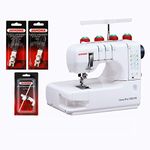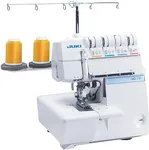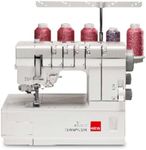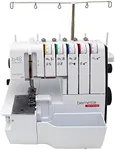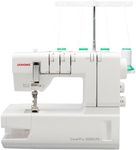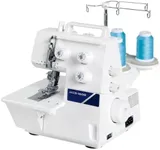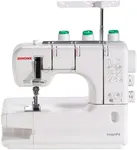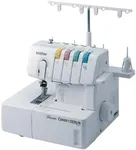Buying Guide for the Best Coverstitch Machine
Choosing the right coverstitch machine can make a significant difference in the quality and efficiency of your sewing projects. Coverstitch machines are specialized sewing machines designed to create professional-looking hems, seams, and decorative stitching on knit and stretch fabrics. When selecting a coverstitch machine, it's important to consider several key specifications to ensure you get the best fit for your needs. Understanding these specifications will help you make an informed decision and find a machine that meets your sewing requirements.Number of NeedlesThe number of needles on a coverstitch machine determines the types of stitches you can create. Most coverstitch machines come with two or three needles. A two-needle machine is suitable for basic hemming and seaming, while a three-needle machine offers more versatility, allowing for wider coverstitches and decorative stitching. If you plan to do a lot of decorative work or need more flexibility in your stitching options, a three-needle machine might be the better choice. For simpler projects, a two-needle machine should suffice.
Stitch WidthStitch width refers to the distance between the needles and affects the appearance and strength of the stitch. Coverstitch machines typically offer adjustable stitch widths, ranging from narrow to wide. Narrow stitches are ideal for lightweight fabrics and delicate hems, while wider stitches provide more durability and are better suited for heavier fabrics. Consider the types of fabrics you will be working with most often and choose a machine that offers the appropriate stitch width options for your projects.
Differential FeedDifferential feed is a feature that allows you to adjust the feeding of the fabric layers to prevent stretching or puckering, especially on stretchy or knit fabrics. This is important for achieving smooth, professional-looking seams. Machines with adjustable differential feed let you fine-tune the feed ratio to match the fabric type, ensuring consistent results. If you frequently work with a variety of fabrics, a machine with a good differential feed system will be beneficial.
Ease of ThreadingThreading a coverstitch machine can be a complex task, especially for beginners. Some machines come with color-coded threading guides or automatic threading features to simplify the process. If you are new to using a coverstitch machine or prefer a more user-friendly experience, look for a machine with easy threading options. This will save you time and frustration, allowing you to focus more on your sewing projects.
Speed ControlSpeed control allows you to adjust the sewing speed of the machine, which can be particularly useful for intricate or detailed work. Machines with variable speed control let you sew at a comfortable pace, reducing the risk of mistakes and improving precision. If you plan to work on a variety of projects, from simple hems to complex decorative stitching, having the ability to control the sewing speed can enhance your overall sewing experience.
Presser Foot OptionsThe presser foot holds the fabric in place as you sew and can affect the ease and quality of your stitching. Some coverstitch machines come with multiple presser foot options, such as standard, clear, or specialized feet for different techniques. Having a variety of presser feet can expand your sewing capabilities and make it easier to achieve professional results. Consider the types of projects you will be working on and choose a machine that offers the presser foot options you need.
